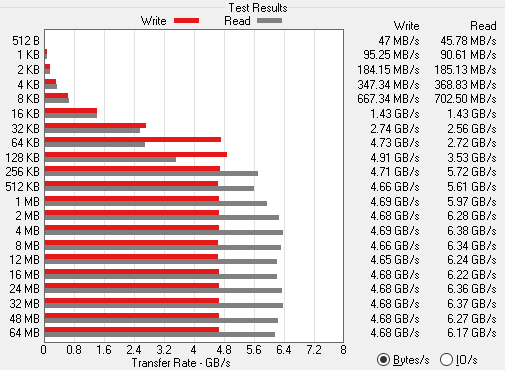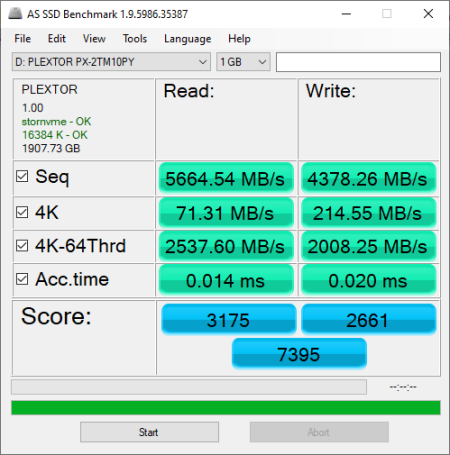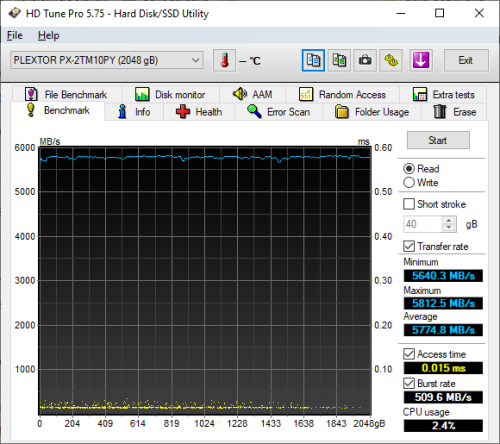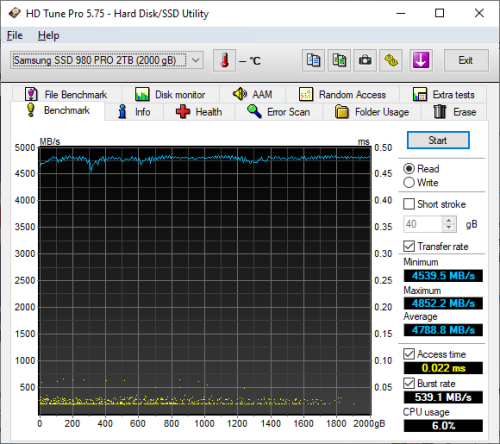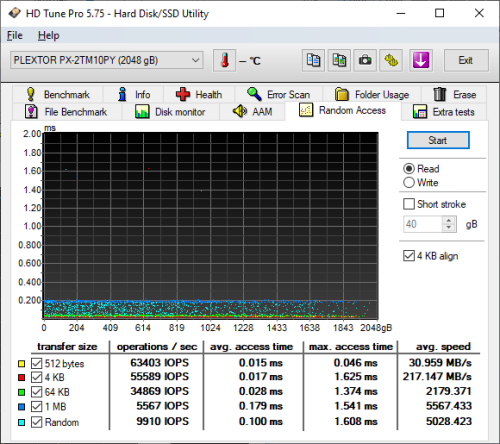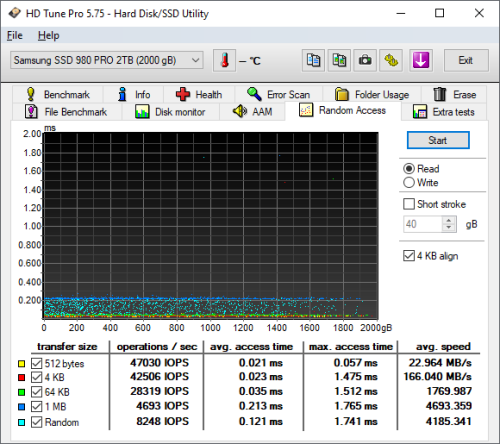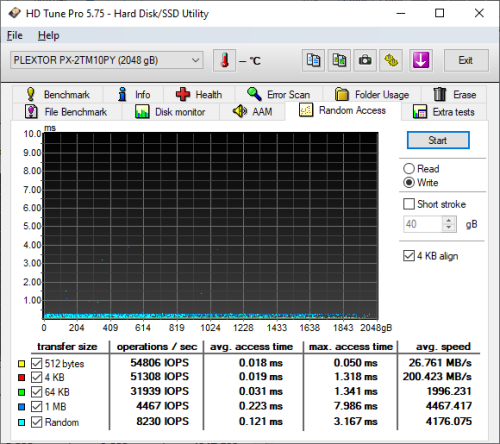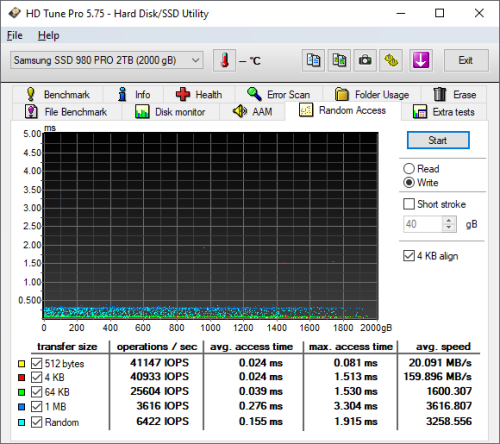

Model: Plextor M10PY 2TB NVMe PCIe 4.0 Solid State Drive
Manufacturer: Plextor
Provided By: Plextor LLC
As one of the biggest names in the storage industry, Plextor doesn't need much of an introduction. For nearly twenty years, they've produced some of the best optical drives the industry has seen. Known the world over for their quality, performance, and features, these drives have become favorites among consumers and professionals alike. Today, Plextor continues to lead the way by bringing cutting edge storage technologies to market. Along with an assortment of high-performance DVD and Blu-ray drives, the company offers a growing number of solid state drives.
Earlier this year, Plextor unveiled its first PCIe 4.0 SSD, the M10P. Designed for avid gamers and audio-visual (AV) enthusiasts, this M.2 form factor drive is powered by Innogrit's Rainier (IG5236) controller and is available with up to 2TB of Kioxia's 96-layer BiCS4 3D NAND flash. The M10P is also equipped with an ultra-fast PCIe Gen4 x4 NVMe 1.4 interface and features support for Plextor's exclusive PlexNitro II cache acceleration and TrueProtect error correction technologies.
Like its predecessors, the M10P is offered in a number of different capacities and configurations. The drive is available by itself in the M.2 2280 form factor (M10PGN), with a small aluminum heatsink (M10PG) and as an HHHL add-in card (M10PY) that's equipped with an extra large heatsink and RGB LED lights. For this review, Plextor sent us the 2TB version of the of the add-in card (M10PY), which is capable of delivering up to 7,000 MB/s sequential read and 5,000 MB/s sequential write speeds along with up to 650,000 random read and 550,000 random write IOPS.
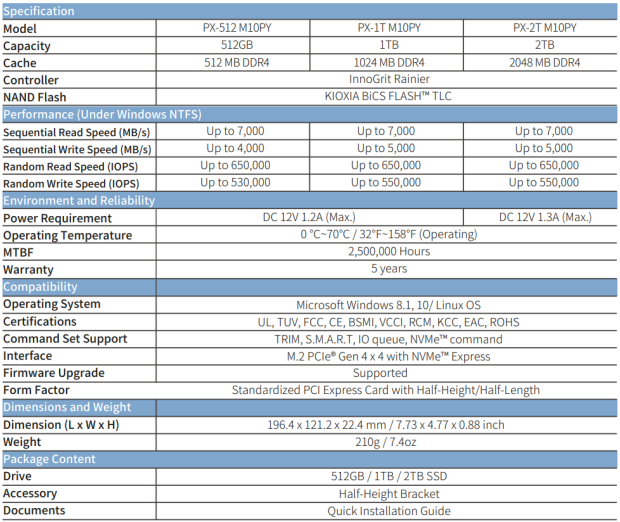
Needless to say, this is only a taste of what the M10PY has to offer. To give you an idea of what to expect, we'll take a closer look at Plextor's new PCIe 4.0 SSD and then see how well it performs. Does the M10PY have what it takes? Can it deliver the performance and features that we've come to expect from Plextor? Keep reading as we find out.
The HHHL (Half-Height/Half-Length) version of the M10P comes packaged in an attractive black and rainbow colored box. The front advertises key features like the drive's PCIe 4.0 interface, 2TB capacity, support for NVMe and 5 year warranty. The back of the box provides a bit more information regarding the M10PY's features, specifications and box contents.


Inside the box, you'll find the M10PY, a low profile, half height bracket for use in servers and small form factor PCs, and a fold out guide containing warranty information as well as some brief installation instructions.

Physical Features:
Like Plextor's previous HHHL SSDs, the M10PY is very well constructed. The top of the PCIe add-in card is covered entirely by a massive aluminum heatsink which uses a series of fins as well as a graphene surface treatment to keep things cool. The M10PY also has a silver bubble with the Plextor logo on it.


Along the top of the M10PY there is a strip of RGB LEDs that light up red when the drive is powered on and will slowly cycle between various colors while it is in standby mode. During a read or write process, the color change speeds up to create a rainbow effect. According to Plextor, the RGB lighting is programmable and can be customized using software from many leading motherboard brands, including Asus Aura Sync, AsRock Polychrome Sync, GIGABYTE RGB Fusion 2.0 and MSI Mystic Light Sync. I tried to synchronize the M10PY's lights with my MSI motherboard but, for whatever reason, the software did not recognize the drive.

If you want to void your warranty, the heatsink can be removed by taking out a few of the screws on the back of the card. With it removed, you can see the large thermal pad that Plextor has sandwiched inbetween the drive and heatsink.

With the heatsink out of the way, you can see the strip of LEDs along the top as well as the SSD itself. The drive is inserted into an M.2 slot and is held in place using a screw.

The M10PY uses Innogrit's Rainier (IG5236) controller. Designed for the high-end client and entry-level datacenter markets, this PCIe Gen 4 x4 NVMe 1.4 controller has 8 NAND channels that can run at up to 1200MT/s. The IG5236 also supports MLC, TLC and QLC NAND and features multiple data encryption and protection schemes including AES, ECC and end-to-end data protection.


For the 2TB version of the M10PY, Plextor has used Kioxia's 96-layer BiCS4 3D NAND flash. Looking at the pictures above, you can see that there are two 1TB NAND flash packages on the top of the PCB. The drive also has a pair of Micron 1GB DDR4 SDRAM memory chips that are used for caching.
The test system used in this review is equipped with an AMD Ryzen 5 3700x CPU, MSI B550 GAMING PLUS motherboard, 16GB (8GB x 2) of Crucial Ballistix 3200 MHz DDR4 memory, Crucial P5 1TB SSD and a GIGABYTE GeForce GTX 1060 WINDFORCE OC 6G graphics card. For the operating system, I used the latest version of Windows 10 Pro.
To test the performance of Plextor's M10PY SSD, I ran a series of benchmarks using CrystalDiskMark, HD Tach RW, ATTO Disk Benchmark, AS SSD, HD Tune Pro, Anvil's Storage Utilities, Iometer and PCMark. For comparison, I've also included test results from the ADATA XPG GAMMIX S70, Sabrent Rocket 4 Plus, WD_BLACK SN850, Silicon Power US70, ADATA XPG GAMMIX S50 Lite, Samsung 980, Silicon-Power UD70, Crucial P2, SK hynix Gold P31, Crucial P5, ADATA SWORDFISH, ADATA FALCON, Lexar NM610, Silicon Power P34A60, Patriot P300, Plextor M9PG Plus, Plextor M9PY Plus, ADATA XPG SX6000 Pro, Western Digital WD_BLACK SN750, Lexar NQ100, Samsung 970 EVO Plus, ADATA XPG SX8200 Pro, Crucial P1, ADATA XPG SX8200, Western Digital WD_BLACK NVMe, Samsung 970 EVO, Samsung 970 PRO, Plextor M9Pe, Plextor M8Se, Patriot Hellfire, ADATA XPG SX8000, Samsung 960 PRO, Toshiba OCZ RD400, Samsung 950 PRO, Samsung 870 EVO, Samsung 870 QVO, Silicon Power PC60 and SK hynix Gold S31.

As I mentioned earlier, the M10PY uses Innogrit's Rainier (IG5236) controller chip. Looking at the screenshot above, you can see that it performs equally well with both incompressible (0%) and compressible (100%) data.
CrystalDiskMark 8.0.4:
First, I ran a few quick tests using CrystalDiskMark. This benchmark measures the performance of a storage device by testing its sequential and random read and write speeds. For this test, we're using the peak and real world profiles.

According to Plextor, the 2TB version of the M10PY is capable of reading at 7,000 MB/s and writing at 5,000 MB/s. While the drive had no problems reaching its rated write speed, it came up short in CrystalDiskMark's sequential read speed test.

As you'd expect, the M10PY wasn't nearly as fast when tested with the "real world" profile which uses a single thread and a much lower queue depth. Nevertheless, it was still able to read at 4,157 MB/s and write at more than 4,500 MB/s.
HD Tach RW 3.0.4.0:
Next, I used HD Tach to test the M10PY's read, write and burst speeds as well as its random access time and CPU usage.

Looking at the screenshot above, you can see that the M10PY had average read and write speeds of 2,807.8 MB/s and 1,590.8 MB/s, respectively, as well as a burst speed of 3,514.0 MB/s. The screenshot also shows that, like most other TLC-based SSDs, the M10PY uses some sort of SLC caching. The drive starts writing at about 2,500 MB/s and then drops to about 1,600 MB/s when the write operation exceeds the size of the cache
ATTO Disk Benchmark 4.01:
I also used ATTO Disk Benchmark to test the M10PY's sequential read and write speeds. The tests are run using blocks ranging in size from 512B to 64 MB and the total length set to 256MB.
When tested with ATTO, the M10PY's read speeds topped out at about 6.48 GB/s and its write speeds at 4.46 GB/s.
AS SSD:
AS SSD is a relatively new benchmark designed specifically for solid state drives. The application contains five synthetic tests used to determine the sequential and random read and write performance of a drive.
AS SSD also includes a copy benchmark. This test copies an ISO (two large files), program (many small files) and game (small and large files), returning the speed and duration of each.
HD Tune Pro 5.75:
Next, I ran a series of tests using HD Tune Pro. This hard disk utility measures a drive's performance by testing its sequential read and write speeds as well as its access time, burst rate and CPU usage. For this review, I'm also going to use it to benchmark the M10PY's random read and write speeds, random access times and the number of operations per second.
The M10PY performed relatively well when benchmarked with HD Tune. The drive had average read and write speeds of 5774.8 MB/s and 2,401.0 MB/s, respectively.
When writing 4KB blocks, the M10PY reached 51,308 IOPS and had an average speed of 200.423 MB/s. The drive was even faster when reading, reaching 55,589 IOPS with an average speed of 217.147 MB/s.
Anvil's Storage Utilities:
Anvil's Storage Utilities is another benchmark designed with SSDs in mind. The standard storage benchmark measures a drive's performance by testing its transfer speeds, access times and IOPS.

Iometer:
Lastly, I ran a series of tests using Iometer. This tool can be configured to benchmark a number of things. In this case, I used it to measure the M10PY's read and write speeds and the number of operations per second. The tests were run using random bytes and a queue depth of 3.
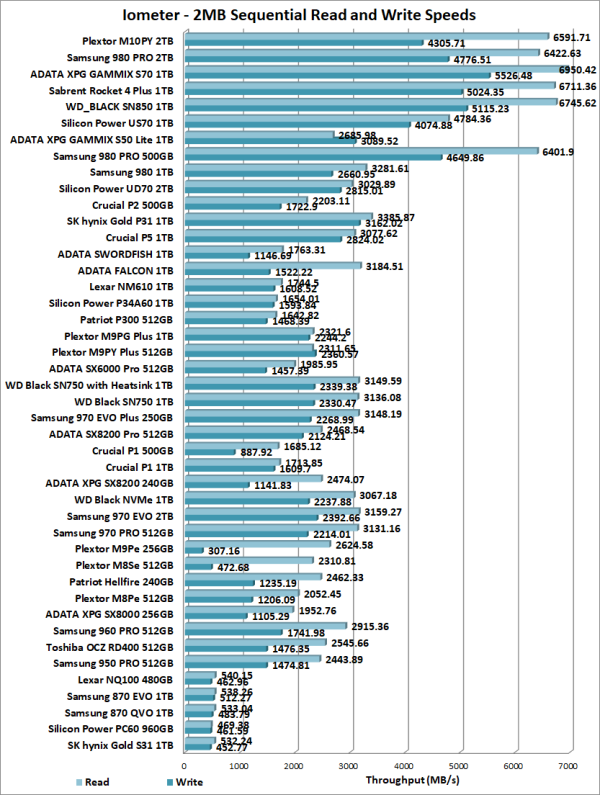
The M10PY's performance was hit and miss when tested with Iometer. While the drive was able to read at an impressive 6591.71 MB/s, its sequential write speed averaged out at only 4305.71 MB/s.
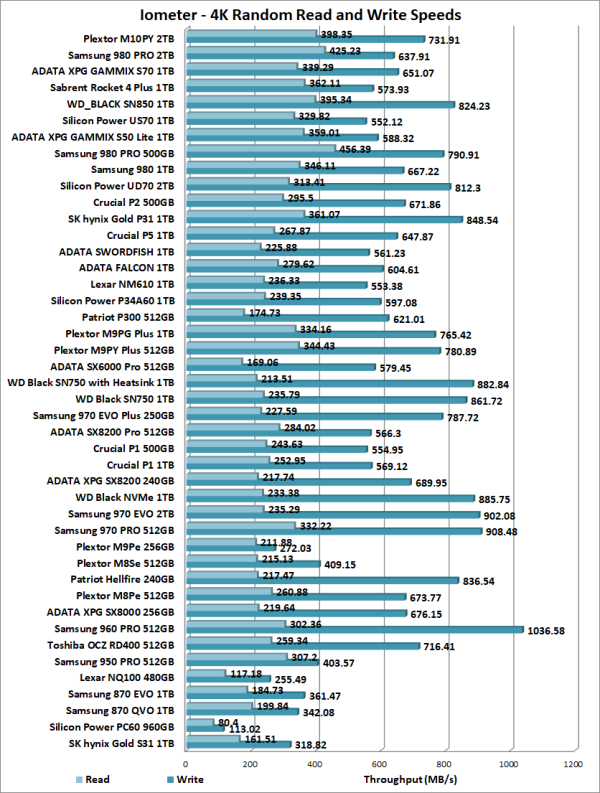
The M10PY also performed very well when doing random reads and writes. In our tests, the drive was able to read at 398.35 MB/s and write at a blazing 731.91 MB/s.

According to Plextor, the 2TB M10PY is capable of 650,000 IOPS when reading and 550,000 IOPS when writing 4K blocks. With two threads and a queue depth of three, the drive reached 101,977 random read IOPS and 187,368 random write IOPS.

As with most drives, the M10PY performed better with more threads and at higher queue depths. With sixteen threads and the queue depth set to 32, it reached 776,956 random read IOPS and 528,276 random write IOPS.
PCMark 8 - Storage Test:
PCMark 8 is a complete benchmark for Windows. It includes five benchmark tests, each designed around a specific scenario. The storage benchmark measures drive performance using real-world traces recorded from Adobe Creative Suite, Microsoft Office and a selection of popular games.

PCMark 8 also includes a consistency test which measures the performance consistency and degradation tendency of a storage system. The test reports the performance level at the start, the degraded steady-state and the recovered state as well as the number of iterations required to reach the degraded state and the recovered state. For this test, we are focusing on the Adobe Photoshop (Heavy) trace and will look at both the bandwidth and latency of the drive


The M10PY didn't do as well as some of the other drives in this test. Its bandwidth dropped below 130 MB/s during the degradation phase, pushing its latency above the 250ms mark. The M10PY's performance increased somewhat during the steady and recovery phases. However, it lagged well behind the drives from Samsung and Western Digital, topping out at only 277 MB/s.
PCMark 10 - Full System Drive Benchmark:
PCMark 10's Full System Drive Benchmark uses a wide-ranging set of real-world traces from popular applications and common tasks to fully test the performance of the fastest modern drives. This benchmark produces an overall score as a measure of drive performance. Comparing devices is as simple as comparing scores. The tests also measure and report the bandwidth and average access time performance for the drive.

Thanks to its high bandwidth and low latency, the M10PY did very well in PCMark 10's Full System Drive Benchmark. It beat both the WD_BLACK SN850 and the Plextor M9PG Plus to take the top spot in this test.
TRIM Performance:
While SSD's offer many benefits, there are some downsides to using flash memory. One of the biggest issues people run into is performance degradation. Over time, an SSD will run out of fresh blocks and will have to write over data the file system has marked as deleted. This procedure is very complicated and can slow an SSD's write speeds considerably.
To fix this problem, most manufacturers have added TRIM support to their SSDs. The TRIM command allows an operating system, such as Windows 10, to tell an SSD which data blocks are no longer in use. Using this information, the drive pro-actively erases these blocks and adds them to the free block pool.

To test the M10PY's TRIM and garbage collection functions, I first put the drive in a "dirty" state. I used Iometer to fill 80% of the drive and then ran a random write test for about 30 minutes. This had little impact on the M10PY's read speed. However, its average writing speed dropped to 281.97 MB/s.

Plextor M10PY - Dirty
To see how well the M10PY could recover, I let the computer sit for about 45 minutes and then reran the test. The drive was able to read at 5488.08 MB/s. However, its write speed lagged behind, averaging out at only 629.52 MB/s.

Plextor M10PY - After TRIM
Lastly, I used Parted Magic to perform a secure erase on the M10PY. With the drive wiped clean, it had average read and write speeds of 5678.92 MB/s and 4512.33 MB/s, respectively.

Plextor M10PY- Secure Erased
Heatsink Performance:
While faster than their SATA-based SSDs, PCIe drives like the M10PY tend to generate more heat. In fact, if your computer doesn't have enough airflow or a large video card covering your M.2 slots, they can get quite hot. To prevent themselves from overheating, most SSDs have implemented a mechanism called thermal throttling which automatically reduces a drive's performance when it reaches a certain temperature.
If you're someone looking to get the most out of your SSD, this is something that you don't want to happen. To address this, Plextor offers the M10P with our without a heat sink. In the case of the M10PY, the entire HHHL card is covered by a massive die-cast heat sink.

The M10PY's heat sink did a great job of keeping it cool. At idle, the drive's temperature measured 28 ºC. Under heavy loads, the M10PY reached temperatures as high as 43 ºC when reading and 44 ºC when writing. These temperatures had no impact on the drive's performance. No matter how hard I pushed it, the M10PY did not throttle its read or write speeds in any noticeable way.
Final Thoughts:
Despite coming late to the PCIe 4.0 party, Plextor has really knocked one out of the park with its M10P series SSDs. Available with or without a heatsink, this M.2 form factor drive is by powered by Innogrit's Rainier (IG5236) controller and is available with up to 2TB of Kioxia's 96-layer BiCS4 3D TLC NAND flash. Combine this with an ultra-fast PCIe Gen4 x4 NVMe 1.4 interface and you have a drive capable of reading and writing at nearly twice the speed of Plextor's previous PCIe SSDs. In our sequential read and write tests, the 2TB version of the M10PY was able to read at speeds as high as 6,945 MB/s and write at speeds in excess of 5,000 MB/s. It also did quite well in our random write tests, producing more than 187,000 IOPS at low queue depths.
Of course, fast read and write speeds aren't the only things the M10P series has to offer. The drive is equipped with a large DRAM cache buffer and features Plextor's exclusive PlexNitro II and TrueProtect technologies. The M10PY ups the ante even further with a massive, die-cast heat sink as well as programmable RGB lighting. To top it all off, the M10P series is backed by a generous 5 year warranty.
Plextor's M10P series is available now in parts of Asia in 500GB, 1TB and 2TB capacities. Prices in Japan currently range from about 11,000 Yen (~$100) up to 45,500 Yen (~$415) for the 2TB HHHL version reviewed here. Currently, Plextor has no plan to bring the M10P series to the US market but we can hope that this will change in the future.

Highs:
- Available in 500GB, 1TB and 2TB capacities
- PCIe 4.0 x4 interface with NVMe protocol
- Innogrit Rainier (IG5236) controller
- Equipped with Toshiba 96-layer BiCS4 3D TLC NAND
- Excellent sequential read and write speeds
- Good random read and write performance
- Supports Plextor's PlexNitro II and TrueProtect technologies
- Programmable RGB lights on M10PY
- M.2 2280 and HHHL PCIe form factors
- Large DRAM cache
- 5 year warranty
Lows:
- Write speed drops when SLC cache is full
- Does not support hardware based encryption
- Pricey
- Limited Availability

